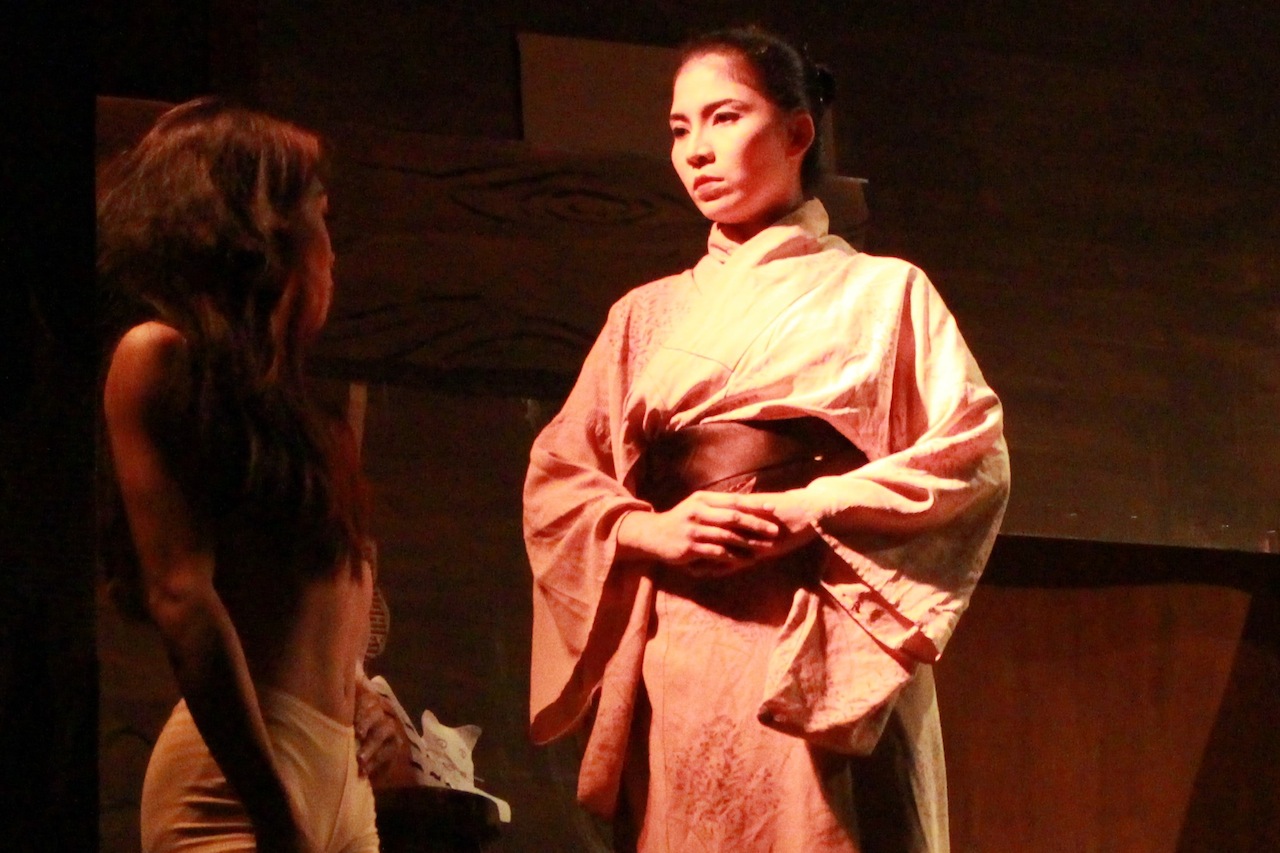
REVIEW: Love is passé in Artist Playground’s “Fly Me To The Moon”
“Someone else is playing my role now,” says the Karayuki as she notices Melanie mirroring the struggles of her life. “Fly Me To The Moon” is about the vicious cycle of social oppression, where love – in this case – cannot conquer all.
Artist Playground’s one-act play (written by Rody Vera) tells the story of a Karayuki (a Japanese girl forced to work as a prostitute in neighboring Asian countries during the 19th to 20th centuries), and Melanie, a transgender Filipino japayuki, who meet on a ship to Japan. Despite coming from different times and cultures, they discover parallels in their lives, experiencing similar tragedies that push them into a cycle of oppression and abuse. As Melanie learns to empower herself, she eventually delivers justice for a crime against her – and in an allusive fashion, also delivers justice for Karayuki-san.
Dea Formacil plays the ghost of the Karayuki. She embodies her character, looking like a geisha in a kimono and white make-up. Formacil makes her role believable with her uchimata gait (a sway in how Japanese women walk) and her Japanese accent. Bitter but composed, Formacil as the Karayuki narrates how her family sold her so her brother can buy land, because in Japan, “you weren’t a man until you could buy land.”
Midway in the play, as a voice in a news bulletin announces, “Times have changed – to have karayuki-san in your family is a disgrace,” Formacil’s Karayuki wails for her lost dignity and the betrayal of her country, repeating “I made them all men!” through tears, which was a moving and equally angering moment. It was made more emotional by the play of blue and red colored lights (by Glenn Caspe) that allude to sadness and anger. The set of “Fly Me To The Moon” (by Caspe, Josh Adamero, and Joyan Que) resembles the interior of a worn-out ship cabin elevated as a main stage. The lower areas become various settings and times, like the audition venue for japayukis in the Philippines, or the meeting place of the Karayuki and her secret Muslim lover, Ibrahim (Clifford Gonzales), under the moon. Everything looks dark and glum, matching the tragedies of the story.
One of the Karayuki’s greatest sorrows is her love story with Ibrahim. We see Gonzales switch between the mysterious Ibrahim and a cat who interestingly keeps the Karayuki and Melanie company. Why a cat? Director Paul Jake Paule hints at reincarnation, and he furthered other smart directing choices with the inclusion of flashbacks that helped the significant events in the narrative materialize. Paule’s choice to use a different actor for a past Melanie, but not for the Karayuki, was an ingenious way to indicate person from ghost.
Paule also used the same actor as the Karayuki’s boss and the ship captain, played by Jun Nayra, highlighting the same cycle of abuse from past to present. Nayra can easily be mistaken for someone Japanese due to his looks, his fluency in delivering his lines in Japanese, and his accent when speaking in English. His facial expressions alone, as the captain, show bewilderness and disgust as he lusts for Melanie. As the Karayuki’s boss, on the other hand, he is unfeeling and cruel upon her death.
Melanie is a stark contrast to the Karayuki. Played by Xosh Ardio, she is full of life and determination. Ardio as Melanie uses song, dance, and references to pop culture in order to communicate the things that the Karayuki doesn’t initially understand. She makes jokes and uses gay-lingo that give comic relief from time to time. Under her lively exterior, however, Ardio shows that Melanie misses home and is scared since she is a stow-away. She says so, but never breaks down, speaking matter-of-factly. She is betrayed by her countrymen on deck, who mock her for having no breasts. She is also abused by the ship’s captain. Ardio expresses Melanie’s desperation and fear when she suddenly becomes timid and pleading with downcast eyes, even going as far as offering to service the captain to save her own life.
“Fly Me To the Moon” tackles timely issues like the plight of women, the LGBTQ, and OFWs, and sexual trafficking and misogyny, but the end-all, unfortunately, was sanitized to a mere love story. With repetition of lines that hint to romance like “Someone else will fall in love, someone else will die for love,” and “This is what love can do to you,” the theme of justice was pushed to the background. As Melanie comes face-to-face with her abuser (the captain) she takes her rightful vengeance, and the Karayuki finds peace. It was a good socio-political and socio-economic statement, watered down by lines about “love.”
“Fly Me To The Moon” tells two stories that parallel in struggle, but is actually one narrative about retribution. It is a dark and tragic production, candid with how misogynistic the world can be. The issues and history it tackles are heartbreaking and enraging, and are more relevant than a love story. In times of oppression, love does not always conquer all. But maybe the pursuit of justice stands a chance.

